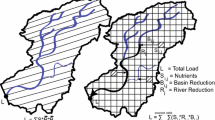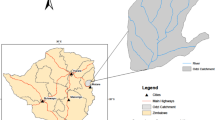Abstract
A previous modeling study (Howarth et al. 1991) showed the potential of a simple watershed hydrology model, the Generalized Watershed Loading Function model (GWLF, Haith and Shoemaker 1987) for estimating annual loads of sediment and organic carbon to the Hudson River from various land uses in the upper portion of the basin. We examined the quality and accuracy of model outputs after making two major modifications. First, we used a geographic information system (GIS) and several environmental databases to improve model estimates of several parameters. Second, we evaluated alternative methods for incorporating weather data.We examined seasonal variation of model output as well as annual averages. Annual fluxes increased over those of Howarth et al. (1991) by 10% for sediment and 20% for TOC for the Hudson-Mohawk basin, resulting in closer agreement with measurement-based estimates. The estimated fluxes exhibited a strong seasonal component, with greates sediment load occurring during a few sping events. Finally, model estimates of fluxes associated with forested and agricultural scenarios, characteristic of earlier periods of the region’s history, predicted a doubling of sediment and TOC loading in an agriculturally dominated Hudson basin but a reduction of sediment by 90% and of TOC by 60% in a completely forested basin.
Similar content being viewed by others
Literature Cited
Berry, J. K. andJ. K. Sailor. 1987. Use of geographic information system for storm runoff prediction from small urban watersheds.Environmental Management 11:21–27.
Bond, M. C. 1947. 1945 census data, New York, by conties. Cornell University Department of Agricultural Economics series AE 589–646. Cornell University, Ithaca, New York.
delRegno, K. J. and S. F. Atkinson. 1988. Nonpoint pollution 0 and watershed management: A remote sensing and geographic information system (GIS) approach.Lake and Reservoir Management 4:17–25.
deVore, J. L.. 1987. Probability and Statistics for Engineering and the Sciences. Brooks/Cole, Monterey, California.
Ellsworth, J. M. 1986. Sources and sinks for fine-grained sediment in the Lower Hodson River.Northeastern Geology 8:141–155.
Environmental Systems Research Institute. 1990. Understanding GIS: The ARC/INFO Method. Environmental Systems Research Institute. Redlands, California.
Fruci, J. R. and R. W. Howarth. 1989. Carbon nitrogen, and phosphorus loading to the tidal, freshwater portion of the Hudson River estuary from point and nonpoint sources: Preliminary analyses. Technical report to the Hudson River Foundation, New York.
Gladden, J. B., F. R. Cantelmo, J. M. Croom, andR. Shapot. 1988. Evaluation of the Hudson River ecosystem in relation to the dynamics of fish populations.American Fisheries Society Monograph 4:47–52.
Godunova, E. K. 1987. Jensen Inequality,In Encyclopaedia of Mathematics. Kluwer Academic, Dordrecht, The Netherlands.
Goebel, J. J. andR. K. Dorsch. 1986. National Resources Inventory: A Guide for Users of 1982 NRI data files (revised). Soil Conservation Service, United States Department of Agriculture, Washington, D.C.
Haith, D. A. andL. L. Shoemaker. 1987. Generalized watershed loading functions for stream flow nutrients.Water Resources Bulletin 23: 471–478.
Halliday, S. L. andM. L. Wolfe. 1991. Assessing ground water pollution potential from nitrogen using a geographic information system.Water Resources Bulletin 27:237–245.
Hirsch, R. M., D. R. Helsel, T. A. Cohn, andE. J. Gilroy. 1993. Statistical treatment of hydrological data. Chapter 17In D. R. Maidment (ed), Handbook of Hydrology McGraw-Hill, New York.
Howarth, R. W., J. R. Fruci andD. Sherman. 1991. Input of sediment and carbon to an estuarine ecosystem: Influence of land use.Ecological Applications 1: 27–39.
Howarth, R. W., R. Schneider, andD. P. Swaney. 1996. Metabolism and organic carbon fluxes in the tidal freshwater Hudson River.Estuaries 19:848–865.
Kesner, B. T. andV. Meentemeyer. 1989. A regional analysis of total nitrogen in an agricultural landscape.Landscape Ecology 2:151–163.
Metcalf and Eddy, Inc. 1979. Wastewater Engineering: Treatment, Disposal, Reuse. McGraw-Hill, New York.
New York State Department of Environmental Conservation. 1987. Descriptive Data of Sewage Treatment Systems in New York State. New York State Department of Environmental Conservation, Division of Water, Albany, New York.
Novotny, V. andG. Chesters. 1981. Handbook of Nonpoint Pollution: Sources and Management. Van Nostrand Reinhold, New York.
Panuzio, F. L. 1965. Lower Hudson River siltation, p. 512–550.In Proceeding of the Federal Interagency Sedimentation Conference, 1963, Miscellaneous Publication 970, Agricultural Research Service.
Petach, M. C. 1989. Integrating and analyzing spatially variable soil properties for land evaluation M.S. Thesis, Cornell University, New York.
Petach, M. C., R. J. Wagenet andS. D. DeGloria. 1991. Regional water flow and pesticide leaching using simulations with spatially distributed data.Geoderma 48: 245–269.
Roehl, J. W. 1962., Sediment source areas, delivery ratios, and influencing morphological factors. Publication, Number 59, IASH Commission on Land Erosion, 202–213.
Sagona, F. J. 1991. Combining remote sensing and biological monitoring to assess watershed nonpoint source, pollution. Paper presented at American Fisheries Society Northwest Division Symposium, Newport, Rhode Island.
Soil Conservation Service. 1983. National Engineering Handbook. Section 3, Sedimentation. Chapters 1–9. NTIS # PB85-199339. National Technical Information Service, Springfield, Virginia.
Snedecor, G. W. andW. G. Cochran. 1989. Statistical Methods, 8th edition. Iowa State University Press, Ames, Iowa.
Stuebe, M. M. andD. M. Johnston 1990. Runoff volume estimation using GIS techniquesWater Resources Bulletin 26: 611–620.
Trimble, S. W. 1977 The fallacy of stream equilibrium in contemporary denudation studies.American Journal of Science 277: 876–887.
United States Geological Survey. 1986. Land use and land over digital data from 1:250,000-and 1:100,000-scale maps Data Users Guide 4. United States Geological Survey, Reston, Virginia.
Vanoni, V. A. (ed.) 1975. Sedimentation Engineering. American Society of Civil Engineers, New York.
Williams, A. P. andR. P. C. Morgan. 1976. Geomorphological mapping applied to soil erosion conservation.Journal of Soil and Water Conservation 31: 5–9.
Author information
Authors and Affiliations
Corresponding author
Rights and permissions
About this article
Cite this article
Swaney, D.P., Sherman, D. & Howarth, R.W. Modeling water, sediment and organic carbon discharges in the Hudson-Mohawk basin: Coupling to terrestrial sources. Estuaries 19, 833–847 (1996). https://doi.org/10.2307/1352301
Received:
Accepted:
Issue Date:
DOI: https://doi.org/10.2307/1352301




